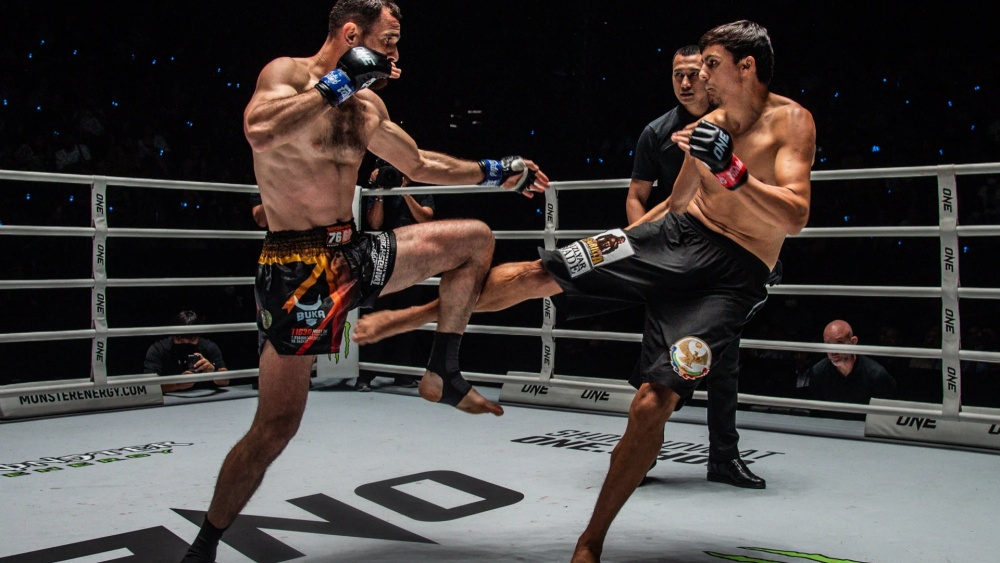
Muay Thai is a game of ranges. The sport’s eight weapons make it possible for bouts to be fought at long range with teeps and kicks, mid-range with punches and knees, or close range with clinch and elbows. This versatility can often make for exciting fights such as when a kicker meets a clincher and both athletes struggle to keep the exchanges in the range where they are most comfortable.
While each style is equal, it can be incredibly difficult for a close-range fighter to get the upper hand if their opponent is skilled at fighting off the back foot, especially in the early rounds when they are at their sharpest. In this scenario, the close-range fighter might lose the early rounds while wearing their opponent down, but once they close the distance, it’s a race against the clock to regain the lead before the fight ends.
If you are a close-range fighter who struggles to get past a kicker’s long-range weapons, you’ve probably experienced many rounds of frustration every time a teep keeps you out of striking range, or when your opponent slaps you with a kick and retreats whenever you attempt to initiate an exchange. If this is the case, fret not – we’ve devised 5 techniques to help you quickly bridge the gap from long to short range while keeping yourself protected from your opponent’s infuriating long-range weapons.
1) The “Hop”
The Muay Thai hop is a simple and effective technique used to close the range quickly while protecting you from your opponent’s defensive teeps.
To do a Muay Thai hop, you need to posture your weight back onto your rear foot as if you are about to teep. Then, while keeping your hands tight to your temple and lowering your elbows, lift your lead knee high to your chest to create a shield with the boniest parts of your limbs which will protect you from your opponent’s teep, hurting their own if they attempt to throw one.
Once you are in this position, hop long and low across the canvas so that your foot doesn’t completely leave the mat. Once you are in range, place your front foot back onto the floor and use it to drive a savage knee or elbow.
While this technique is incredibly useful, a cool-headed fighter may simply step back out of range when they see you raise your front foot. If this happens to you, it is much easier to use this technique when they are already backed onto the ropes, limiting their options for escape.
2) The High March
The high march is a tried and tested technique used by Muay Khao fighters who want to quickly and safely enter the clinch range. Much like the ‘hop,’ a fighter using this technique will shift their weight onto one leg, close their guard tight, and lift their knee high to their chest to create a defensive shield. Instead of hopping, they simply step forward and lower their foot back down, repeating the movement with the other leg.
This is a great option to use against an opponent who retreats when you attempt to hop, as you can continue marching and even change directions until you corner them. Just make sure to take small steps while marching, as longer steps make it harder to maintain balance and give your opponent more opportunities to exploit openings in your shield.
3) The Slide
The Muay Thai slide is essentially a feint that mimics the first movements of a roundhouse kick, tricking your opponent into blocking as you close ground.
Starting from slightly out of range take a big step forward with your lead leg as if you are about to roundhouse kick. Then drag your rear leg behind you so your foot slides across the canvas as you lift your hip and lower your rear arm to your hip as if you are beginning to kick. You need to do this quickly so that they feel an urgency to defend.
If your opponent plants themselves to block or catch the feinted kick, there will be a moment in which they are stationary. You’ll need to step forward, returning to a balanced stance, closing the final gap to unload punches, ideally while your opponent is still lowering their block.
4) The Step-Through Cross
If your opponent is adept at staying slightly out of punching range, then a step-through cross is the perfect way to close ground quickly to catch them off guard.
Begin by throwing a jab, or cross combination to assess your opponent’s reaction. If they step back from range as you move forward to punch, then you know this technique will work.
The next time you engage, throw a jab with the intent to hit them, and then, knowing they will step back, throw your cross whilst simultaneously stepping forward with your rear foot so that you land in your opposite stance. Make sure not to put too much power into the second punch, as it’s almost certain to miss. Fully rotating into it will drag your foot across your body, leaving you off-balance and exposed.
Once you have landed forward in your opposite stance, assess your range. If your opponent is retreating, you can step through with a left kick to catch them on the way out or, if they are close to the ropes, you can step through again into your preferred stance to unload them with your close-range weapons.
Conclusion
Mastering the art of bridging the gap between ranges can make all the difference for close-range fighters facing skilled long-range opponents. By utilizing techniques like the hop, high march, slide, and step-through cross, you can effectively close the distance while staying protected. With practice and strategic application, these methods will help you overcome frustrating opponents and dominate in close-range exchanges.
You may also like:
5 Bodyweight Exercises To Increase Kicking Power For Muay Thai
When training Muay Thai, increasing your kicking power comes down to two aspects – your technique and your physical ability. Many Nak Muays focus heavily on technique, and rightfully so, but often forget to pay…
Muay Thai is the national sport of Thailand and, until recently, the way a fight was scored was dictated by the elite Thai stadiums. It was a nuanced system, somewhat influenced by elements of chance…
Sweeps are some of the highest-scoring techniques in Muay Thai. Knocking an opponent’s legs out from under them and sending them crashing to the canvas requires exceptional timing and skill. The mere sight of you…
Fans of ONE Championship’s Friday Fights at Lumpinee Stadium will be familiar with the name Nabil Anane. Standing at 192 cm, the Thai-Algerian is not only one of the tallest fighters in the ONE arena…
In Muay Thai, laying traps can be risky business. Even with all the right skill, technique, and planning, they are still a gamble; can you subversively impose your will on your opponent? Will you be…
In Muay Thai, Muay Mat is an aggressive and powerful breed of Nak Muay who specialize in delivering powerful punches to inflict damage on their opponents. As punches are a conditionally scoring technique under the…
The L-step is one of the footwork techniques that separates amateurs and professionals in boxing. Good footwork is essential to enjoy any level of success inside the ring. Your feet are one of your most…
The pocket is one of the most dangerous distances in MMA. From the pocket, both fighters can unleash their entire arsenal of striking and grappling. Some of MMA’s most exciting moments come from exchanges in…
Wrestling is the oldest form of martial art in the world. As we advance to the modern age, innovation around wrestling has allowed it to be played with different styles and rule sets, bringing all…
Whether you’re an athlete, bodybuilder, or someone dedicated to maintaining physical fitness, muscle recovery is a critical component of training. Without proper recovery, your muscles don’t have the opportunity to repair, rebuild, and strengthen after…
If you’re often at KINEX Mall for a good ol’ round of boxing, Muay Thai, Brazilian Jiu-Jitsu, or mixed martial arts session at Evolve MMA, you might be wondering whether there are lovely places to…
The underhook is an aspect part of grappling in BJJ. It is a hold that gives a strategic advantage by enabling strong control over an opponent and, at the same time, a good spot for…




































